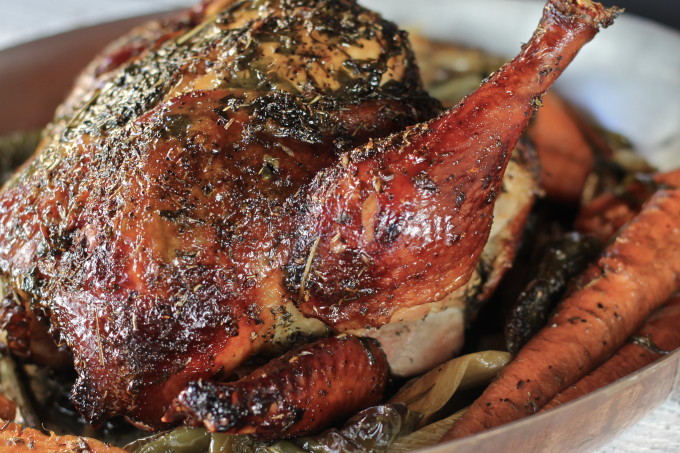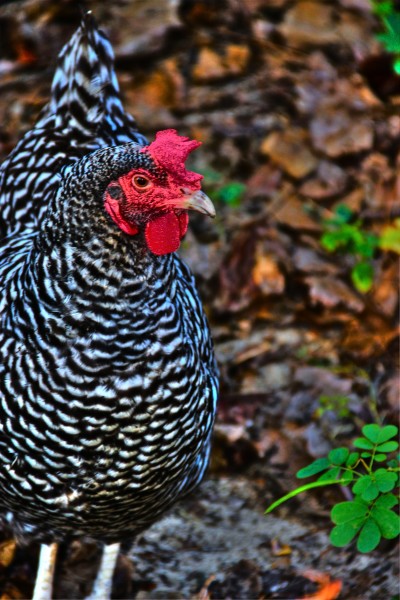Roasting a whole chicken is as basic to French Acadian cooking as it is to French Provencal cooking. Although the spice blends vary and most Louisianans would be stumped at the thought of trussing a bird, the two cultures still elevate the lowly poulet to a stellar dish.

Perfect herb-roasted chicken is a French technique and a traditional Cajun recipe. (All photos credit: George Graham)
It seems these days that roasting a whole bird is a dying art. With the proliferation of supermarket rotisseries that spit out chickens with any number of herb-infused variations, why bother. While most are acceptable and some are downright delicious, I do believe there is an artistic expression in the act of roasting a whole chicken that is being lost on our next generation.
The French inspire me with their culture based on farm-fresh food sourcing and culinary techniques that have become the very principles of cooking. There is a certain elegance to French cooking that elevates each dish to a higher level. Many reasons for this blog are based on my connection to French cooking through the Cajun recipe roots of my Acadiana. But c’mon, how difficult does roasting a chicken have to be?
I sense a conspiracy. I theorize that over the last 100 years the French have intentionally intimidated us Americans into thinking we could never achieve kitchen greatness by making the otherwise simple dish of roast chicken so complicated. You only have to watch an online video of Jacques Pepin effortlessly flinging string across a bird, trussing wings and legs into an intricate geometric maze, to see their culinary propaganda machine at work.
This–I continue to theorize–is the fundamental reason America has so readily embraced fried chicken. Who has kitchen twine? Who knows a French butcher’s knot? Who cares if the leg happens to flop open or, God forbid, the wing tips burn?
So, a friend asked me recently about roasting a chicken and wanted to know when I would post a recipe on my blog. I laughed and told him my theory. He laughed and called me scared. He was right. So, for all Americans who’ve shied away from roasting a whole bird, here is my Americanized, or at least Cajunized, Herb-Roasted Chicken recipe.
In all its glorious simplicity, I will admit there are some basic principles that should be followed. First, find good chicken. All chickens are not created equal. No store-bought, chemically enhanced, hormone-induced birds here. I am not an organic evangelist, but there are some things–chickens, for sure–that should be raised naturally close to the ground. Go to a source you trust. Find a local supplier who has fat birds running around the front yard. This is your tip-off to a free range yard bird that is not pumped with hormones and other unmentionables. Visit the Lafayette Farmers and Artisans Market at Moncus Park on Saturday morning, and you should be able to find a source for a quality, free range roasting chicken for your Herb-Roasted Chicken recipe without too much trouble.
The next step is defining the flavor objective of your herb-roasted chicken by determining the selection of dry seasonings and spices as well as aromatics and vegetables. Keep it simple. Most cooks tend to overcomplicate the simplest dishes–roast chicken being a prime example. Heavy-handed seasoning and the dreaded stuffing are the worst mistakes. This Cajun recipe for Herb-Roasted Chicken uses a minimum of ingredients and treats the natural flavor of the bird with respect. What’s in your pantry? What’s in your herb garden?
The key to roasting chicken is to infuse flavor. Inside, outside and underneath, there are multiple touch points to add moisture and flavor. I happen to have an abundance of Meyer lemons from my tree along with fresh thyme and a stalky rosemary bush in need of serious trimming–all are classic flavors of a perfect roast chicken. With a handful of aromatic vegetables–carrots, onions and celery–I have essentially all the ingredients at hand for my Herb-Roasted Chicken.

Find naturally raised, free range chicken.
- 4-pound roasting chicken
- 4 large Meyer lemons
- 4 sprigs fresh thyme
- 4 sprigs of rosemary
- 1 large onion
- 2 carrots
- 2 stalks celery
- Kosher salt
- Freshly ground black pepper
- ½ cup canola oil
- Melted butter
- Chicken stock, if needed for sauce
- 2 tablespoons cornstarch
- 4 tablespoons cold water
- Preheat the oven to 350ºF.
- Take the chicken out of the refrigerator at least one hour before cooking.
- Slice one of the Meyer lemons and quarter the rest. Rinse the thyme. Rinse the stems of rosemary and trim off the woody ends. Peel and quarter the onions and slice the carrots and celery into large chunks.
- Pat the chicken dry. Loosen the skin along the breasts and thigh areas by running your fingers underneath. With a brush or your hands, coat the chicken with canola oil. Sprinkle the bird all over and inside the cavity with Kosher salt and freshly ground black pepper.
- Place a couple of chunks of the onion, carrots and celery into the cavity along with several of the quartered lemon pieces and one sprig of rosemary and thyme.
- Lift the skin and shove slices of lemon and sprigs of rosemary and thyme underneath. Continue until you have covered as much of the chicken as you can.
- In a large roasting pan with a rack, place the chicken on the rack and add all of the leftover vegetables, lemon and herbs underneath the bird.
- Cover the pan with aluminum foil, but try not to wrap the chicken skin. Place into the oven and let it roast for 45 minutes.
- Remove from the oven and uncover. Remove the lemons and rosemary stems from under the skin and let the chicken roast (uncovered) for another 15 minutes.
- At this point, check the internal temperature of the chicken with a probe thermometer inserted at the thickest part. It should be at least 165ºF.
- Brush the skin of the chicken with melted butter and return the chicken to the oven with the temperature set to broil. Watch it carefully. This is a crucial point to brown and crisp the outside skin of the chicken, but being careful not to burn or blacken. This will take a matter of a minute or two.
- Once browned, remove from the oven and let rest before carving.
- Drain the juices into a saucepan, and if needed, add more chicken stock to make a sauce. Thicken on low heat with a slurry by mixing the corn starch with cold water and bringing to a boil. When it reaches the proper thickness remove from the heat.
- Slice the chicken and serve with the sauce along with mashed potatoes and vegetables of your choice.

A delicious French-roasted bird and one hungry French poodle.
YOUR SEAT AT THE TABLE: If you like this Cajun cooking story and Cajun recipe then accept my personal invitation to subscribe by entering your email at the bottom or top right of this page. It’s quick and painless. You will receive an email alert and be the first to see when new Cajun cooking stories and Cajun recipes are added.
Thanks, George.
Hi George, I remember meeting you in 1977 when I moved to Lafayette to work in the banking industry and you were the owner of an Ad Agency. I have been a subscriber of Acadiana Table for over a year and really enjoy reading your stories, photos and recipes. I am now buying my sausage at Rabideaux’s market in Iowa LA, my turkey wings at the Piggly Wiggly at four corners in Lafayette, LA and being from Crowley LA certainly a fan of Supreme Rice. Your recipes are simple and the results are delicious. I had a mother-in-law in Eunice LA and my wife and I enjoyed her wonderful cooking, fresh fish on Friday nights and Sunday dinners, not one ever prepared from a recipe but better than any famous restaurant from New Orleans to Houston. Reminds me or your mother-in law north of Jennings. Please keep up the good work.
Hey Richard – I remember you as well and thanks for the great comments. Here in Acadiana, food unites us all and fills our lives with colorful memories. Thanks for sharing with us. George
I have been roasting chickens almost every week for over 30 years and I do it in much the same manner as done here. I put garlic slices and rosemary sprigs under the breast skin, but no lemon, and I leave them in. I haven’t trussed a bird since I don’t know when, but I do twist the wings and fold them under the back and after filling the cavity. I run a skewer up through the fanny and stitch it through the 2 skin flaps, through the tips of the legs and then the breast bone. I place it breast side down in an iron skillet and roast at 400° 20 minutes. I lower the oven to 375°, flip the bird and cook about 45 minutes. I make the gravy the same way as here.
Hey John-Christopher – Thanks for the comment and the idea of the 400ºF iron skillet. I’ll try that next time. Best, George
When you put the bird back into the oven after the 45 minutes, do you leave it uncovered?
Yes, uncovered. And thanks for pointing out that my instructions are not entirely clear. I have updated the recipe to reflect the additional roasting (uncovered). Best, George
I have an infrared /convection smoker it also roasts and grills….can I use that instead of the traditional oven? It cooks more evenly….
Hey Andy – Should work fine although my recipe’s cooking time will certainly vary with your faster infrared oven. Let us know how it turns out. Thanks for the comment. George
Can’t wait to try this
Beautiful bird! Looks TOO delicious! I have GOT to try this!
I’ve always wanted to roast a chicken properly.
George, does the temp of 350 remain the same through out the process?
Chris-
No. After the chicken is cooked, set the oven to “broil” (step 11) and watch carefully as the skin crisps. Best to you.
A simple roast chicken, done well, is one of the most underrated dishes ever. And it’s not at all difficult to do it well.
Looks delicious, can’t wait to try!
Thank you for sharing these recipes it all looks enticingly delicious! I cannot wait to try these ♥️